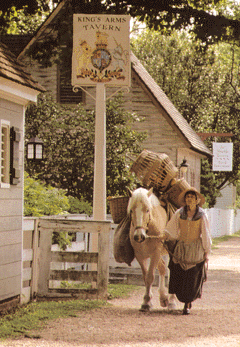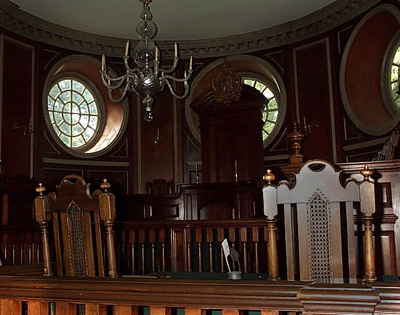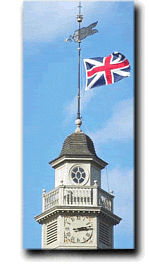




|
|
 |
 |
 |
 |

Back in the 1920s, Williamsburg, Virginia was a rural, tidewater town when
Reverend W.A.R. Goodwin had a vision to restore the area’s historic, Revolutionary-era
neighborhood into a “national shrine.” The local rector of the Bruton
Parish Episcopal Church wanted to revive a colonial village that would stand
to preserve and espouse patriotic, American values of individualism and representative
government. For his dream to be reality, he required a patron and originally
asked the automobile manufacturer, Henry Ford, to make an investment in Williamsburg.
Ford was unconvinced and refused Goodwin’s advances. Eventually, the ambitious
rector sought out John D. Rockefeller Jr., the wealthy capitalist and philanthropist,
to bankroll his project.
With Goodwin’s long-term persistence, Rockefeller finally agreed to the
endeavor after seeing plans drawn up by the architect, William G. Perry. At
the end of 1926, Goodwin began buying up property in the Williamsburg’s
colonial area.
When making his real estates purchases, Goodwin certainly did not let on who
was in the background with the purse strings; he was wary that if Rockefeller’s
name was associated with the undertaking, he would be forced to pay inflated
prices for land and buildings. However, rumors began circulating that only someone
such as the likes of Rockefeller could have the means to purchase so much property
in one town.
Then in a public town meeting in 1928, Goodwin disclosed the identity of his
patron and made his case to the citizens of Williamsburg for the full-fledged
restoration. He presented to them, Colonial Williamsburg, Inc. Most residents
at the meeting were in favor of the redevelopment of Williamsburg’s historic
districts, persuaded by the material rewards that would be an outcome of the
project, but also by the sense of having a renewed identity in the history of
the American Revolution. Only a minority had any objections, but those who did
disapprove adamantly defended their opinions.
The chair of the schoolboard, Samuel D. Freeman, asked the people of Williamsburg
to question what would happen after the transfer [to Rockefeller] had taken
place and the land that they could have owned was in the hands of a private
corporation. As he put it at the town gathering: “[H]ave you all been
hypnotized by five million dollars dangled before your eyes? Can any of you
talk balk to five million dollar?” One local citizen, John Arthur Hundley
criticized that with JDR Jr’s buyout of 95% of the colonial area, they
had essentially sold town and sold the people. The locals would have very little
power to decide the fate of their town’s historic districts once it was
put in the private hands of one of the most powerful families from the North.
There were many in the Williamsburg community that supported the preservation
of their town with private funds. Local leaders realized the important economic
role that tourism was to play in their future. Those in the local chamber of
commerce knew that not only traditional tourist trades—restaurants and
hostelries—but businesses in the area would capitalize on the greater
number of people visiting the town. These members of Williamsburg saw the possibility
for growth and though they didn’t need to attract capital investment because
it was already at their door, they certainly had the mindset of a growth machine
and met Rockefeller halfway in their cooperation with the architects, contractors
and landscapers.
During the early years of the preservation, many residents continued to live
in their houses as they were being restored, but others were forced to relocate
to new dwellings. Many residents did accept the upheaval in their lives because
the restoration brought a surge of wealth into the community. Reconstruction
occurred during the harshest years of the Great Depression and helped to offset
the period’s impoverishment and in some instances, raised the living standards
of local residents. Many people found construction jobs during the rebuilding
years. There were protests from wealthy, established families who felt control
of Williamsburg was being taken away from them, but this minority did not organize
an opposition to counter restoration proponents. Most residents welcomed the
restoration because of the derived economic effects.
However, an important question to ask is not so much how people benefited,
but who benefited? The politics of redevelopment were not always so simple because
groups were affected differently and received different benefits from the restoration.
A more nuanced understanding of the relationship between the forces urbanized
development and local civilians shows that in Williamsburg, differential access
to wealth were drawn mostly along racial lines.
Unlike their the white residents who had the freedom to decide where they could
relocate, many African–Americans were restricted as to where they could
move, and oftentimes their new homes were “so small people [could not]
get their furniture in.” Also, while many whites profited from the restoration,
the wealth and position of African-Americans stayed the same as before. The
whole preservation project also promoted segregation because before moving,
both races had lived on the same streets, but their relocations were controlled
to separate areas.
Colonial Williamsburg as a history museum first opened its doors to the public
in 1935. Visitation steadily rose through the decade, but after WWII the number
of tourists soared. The death of Rockefeller in the 1960s marked a significant
transition for the Colonial Williamsburg Foundation as it found itself in a
precarious financial situation, faced with the challenge of being an “independent
institution that could hold its own in the competitive non-profit world.”
Very quickly, soliciting major financial gifts and enlarging its endowment fund
became new institutional realities. Officials knew that forming a symbiotic
relationship with corporate groups would greatly sustain the colonial Williamsburg
project.
In an effort to provide working capital and to broaden the tax base of the
relatively poor county, it sold a large tract of land to Anheuser-Busch in 1969.
There were varied reactions to this business decision from the local population;
most citizens accused the nonprofit organization of acting as a real estate
developer and selling out to the corporate interests of a brewery industry;
the analogy that proliferated was that Colonial Williamsburg was getting into
bed with a beer baron.
They were concerned about allowing commercial interests to corrupt the image
of a history museum, making it made it more likely that Colonial Williamsburg
would be perceived as a theme park rather than a city-museum. Also, building
the Anheuser-Busch developments would irreparably damage the environment in
and around Williamsburg they criticized. It made it more likely that Colonial
Williamsburg would be perceived as a theme park rather than a city-museum. The
Foundation insisted that bringing Anheuser Busch into the area, it was also
acting out of concern for the overall economic health a county in which it happened
to be the largest employer and taxpayer.
It was agreed that Anheuser Busch would be allowed to use a large portion of
the land for the development of a high-end enclave community called Kingsmills.
Recently, other similar real estate developments by the corporation have appeared
in proximity to the colonial living museum. One such planned community is Ford’s
Colony, which has won awards for its golf course, wine list and country club.
Colonial Williamsburg has given it official stamp of approval to these corporate
developments. “That Colonial Williamsburg sells its advertising space
to Ford’s Colony reveals that the relationship is perceived as symbiotic,
at least potentially…even though the foundation never actively sought
out an association with this corporate neighbor.” Anheuser-Busch built
two large theme parks in Williamsburg, Busch Gardens and Water Country USA.
Colonial Williamsburg has formed alliances with these other tourist attractions,
offering vacation packages to all three destinations as well as the Jamestown
Settlement and the Yorktown Victory Center nearby.
Most likely, many of the social conflicts shaped in the restoration and development of Colonial Williamsburg in the 1930s were reproduced with the growth of Anheuser-Busch’s theme parks. Entrepreneur actors, including local political and business elites as well as investors work in conjunction as they promote and privilege the construction of tourist attractions in addition to hotels and upscale residential communities. They are the one who fuel urban wealth. However, there will be time when antagonisms are created with locals who own land and houses where these things are to be built or who suffer from the negative externalities of nonresidential growth.
Works cited:
Greenspan, Andrews. Creating Colonial Williamsburg. Washington: Smithsonian Institution Press, 2002
Handler R. & Gable E. The New History in an Old Museum; Creating the Past at Colonial Williamsburg. Durham: Duke University Press, 1997.